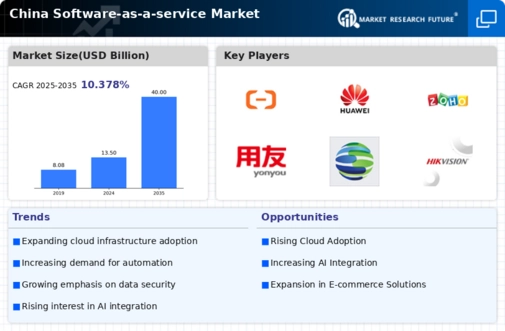Emergence of Niche Market Segments
The software as-a-service market in China is witnessing the emergence of niche market segments tailored to specific industries. As businesses seek specialized solutions to address unique challenges, software as-a-service providers are developing targeted applications for sectors such as healthcare, education, and finance. For instance, the healthcare sector is projected to see a 25% increase in the adoption of software as-a-service solutions by 2025, driven by the need for efficient patient management systems and telehealth services. This diversification within the market not only enhances the value proposition for clients but also allows providers to differentiate themselves in a competitive landscape. As niche segments continue to grow, the software as-a-service market is likely to expand, offering a wider array of solutions to meet diverse customer needs.
Rising Demand for Remote Work Solutions
The software as-a-service market in China experiences a notable surge in demand for remote work solutions. As organizations increasingly adopt flexible work arrangements, the need for cloud-based collaboration tools intensifies. In 2025, it is estimated that approximately 70% of enterprises in China will utilize some form of remote work software, driving the growth of the software as-a-service market. This shift not only enhances productivity but also reduces operational costs, as companies can scale their software needs without significant upfront investments. Furthermore, the integration of features such as real-time communication and project management within these platforms is likely to attract more users, thereby expanding the market's reach. The trend towards remote work is expected to persist, indicating a long-term opportunity for software as-a-service providers in China.
Increased Focus on Data Security and Compliance
In the software as-a-service market, data security and compliance have emerged as critical drivers, particularly in China. With the implementation of stringent data protection laws, such as the Personal Information Protection Law (PIPL), businesses are compelled to prioritize secure software solutions. As of 2025, it is projected that over 60% of organizations in China will invest in software as-a-service solutions that offer robust security features and compliance capabilities. This trend reflects a growing awareness of the risks associated with data breaches and the potential financial repercussions. Consequently, software as-a-service providers that can demonstrate their commitment to data security and regulatory compliance are likely to gain a competitive edge, attracting more clients in a market that increasingly values trust and reliability.
Advancements in Artificial Intelligence and Automation
The software as-a-service market in China is significantly influenced by advancements in artificial intelligence (AI) and automation technologies. These innovations are transforming how businesses operate, enabling them to streamline processes and enhance decision-making capabilities. By 2025, it is anticipated that AI-driven software as-a-service solutions will account for nearly 30% of the market, as organizations increasingly leverage machine learning algorithms to analyze data and improve operational efficiency. This trend suggests a shift towards more intelligent software solutions that can adapt to user needs and provide predictive insights. As companies in China embrace these technologies, the software as-a-service market is likely to evolve, offering more sophisticated tools that empower businesses to thrive in a rapidly changing environment.
Government Initiatives Supporting Digital Transformation
The software as-a-service market in China benefits from various government initiatives aimed at promoting digital transformation across industries. The Chinese government has launched several policies to encourage the adoption of cloud computing technologies, which are integral to the software as-a-service model. For instance, the '14th Five-Year Plan' emphasizes the importance of digital infrastructure, aiming to increase the contribution of the digital economy to GDP by 20% by 2025. This supportive regulatory environment fosters innovation and investment in the software as-a-service market, as businesses seek to comply with new standards and leverage government incentives. Consequently, the market is likely to witness accelerated growth as companies align their strategies with national objectives, enhancing their competitiveness in the digital landscape.




















Leave a Comment